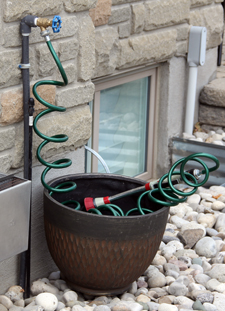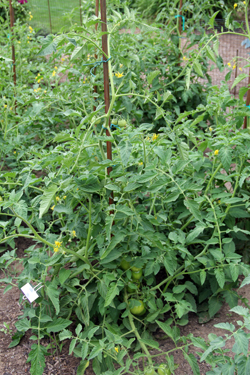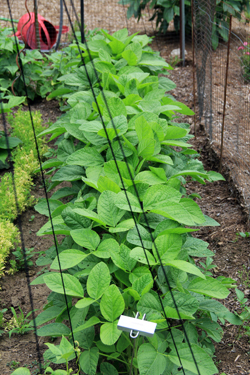I can’t believe it’s mid-July already. Yet here we are, already beginning the height of the season. Like most gardeners, I’ve been busy with spring planting, pruning, weeding and watering. It seems like there is something to do every day — but that is the joy of it. While gardening on a two acre property might seem daunting to some, now that most of the ornamental gardens are planted, all it really takes is a few hours each week to keep everything well tended. Here’s what I’ve discovered so far this year:
- I never walk outside without bending down to pull up a stray weed or two. It is really easy to weed an entire bed in 10 minutes when the weeds are only 2 inches tall.
- Fifteen minutes each morning keeps my many annual planters watered and pruned. I placed two water supplies near the majority of my planters this year, making it possible to water almost all of my planters using a wand directly from the hose. Much better than when I used to fill and haul a watering can 15 to 20 times to reach everything. In an area where I didn’t have a tap itself, I placed a two-way manifold at a further tap and ran a dedicated hose along the ground to a spot closer to the front planters.
- Tomatoes like compost. Every year we have had issues with the bottom of our tomato plants turning yellow and losing foliage. This year we placed composted horse manure inside each planting hole when the transplants were put in the garden. Then again in mid-June I mulched around the base of each plant with compost from our backyard compost pile. So far the plants look healthier with lots of fruit and flowers as well as nice green foliage.
- Edamame does well in our garden, bok choi does not. Each year we experiment with new crops, seeing what will work and what doesn’t. The trick is to learn from the experiments and keep growing only what grows well in an organic garden without a lot of work. I tried two batches of bok choi this spring, both were severely eaten by bugs. We have however had great success with our kidney beans, edamame, kale and several other vegetables. The jury is still out on the lentils (to the left in the picture below), quinoa and sweet potatoes. Only those that are easy to care for will be granted space next year.
- Lettuce does not have to be succession planted. For the past two years we have successfully eaten from our first and main crop of lettuce all season. Constant harvesting by cutting the tops off about 2 inches from the ground, results in a flush of new growth that is reharvested a few weeks later. This takes up less space and saves a lot of time. I top-dress the edges with compost throughout the season to add nutrients to encourage healthy regrowth. Some cold season lettuces will go to seed, those I just pull out leaving the warmer season tolerant lettuces to take over.
- Everything doesn’t have to be perfect. The back of our property is bordered by a natural scrub brush that, like it or not, is full of invasive weeds like garlic mustard, wild grape, dandelions, wild carrot and more. I used to fret over the amount of weeds that crept forward into our tended woodland and found it to be next to impossible to maintain this area weed free. So now I pick and choose — the gardens around the house I keep as well tended as I can, the vegetable gardens tended enough to keep out pests and ensure an abundance of produce. The back gardens are left more natural, with occasional forays out to pull down grapevine (very therapeutic I might add), pull up or weed-wack taller weeds I don’t want and limb up the hawthorns so we can walk under them without getting skewered. These gardens after all are meant to be enjoyed from a distance.
I’m sure there are more lessons to be learned, but for me those are the big ones this year. Here’s to more happy days in the garden.



